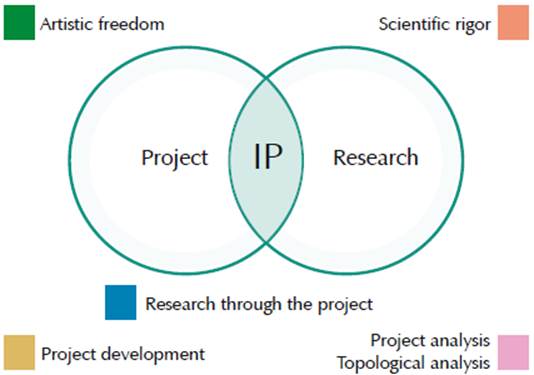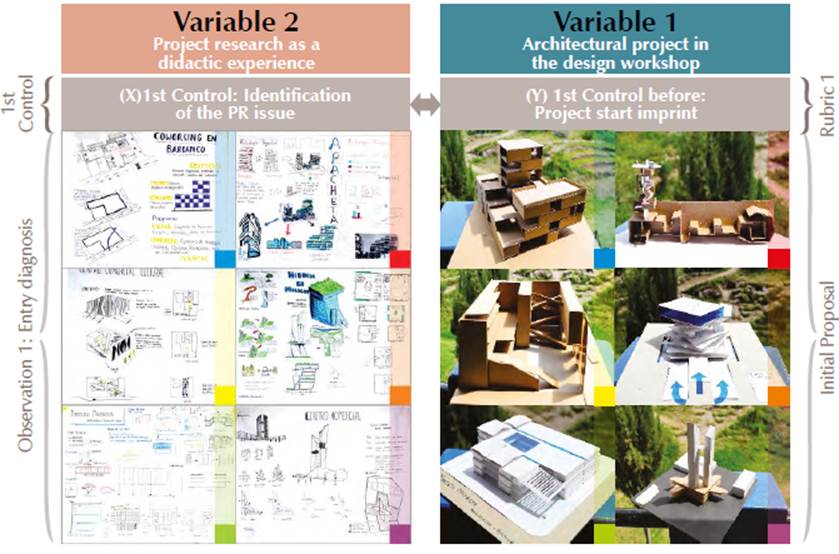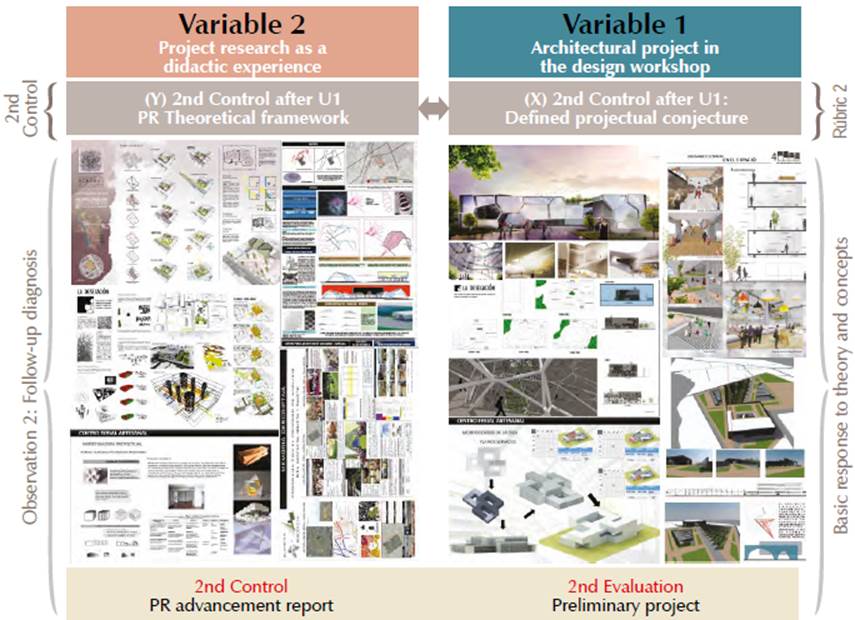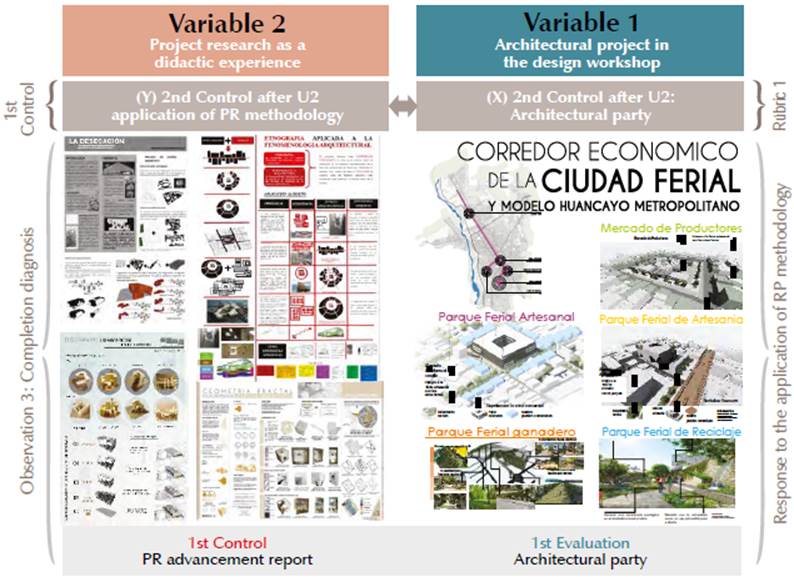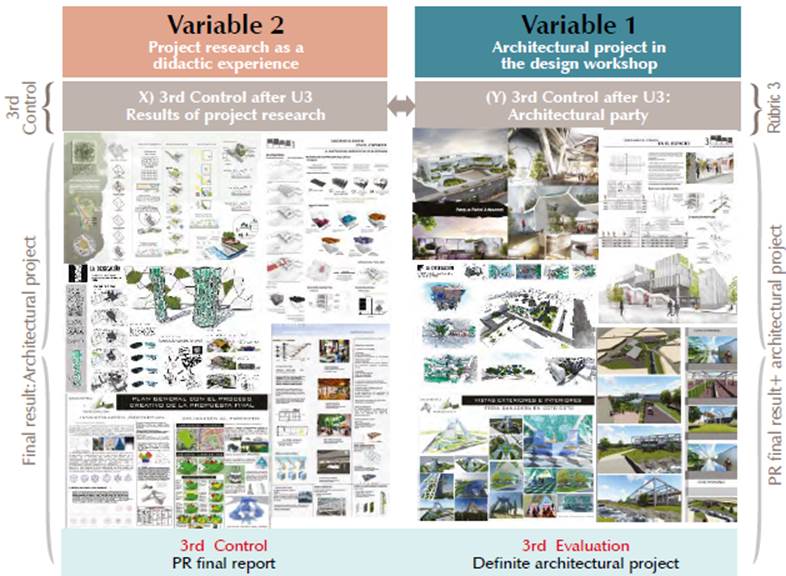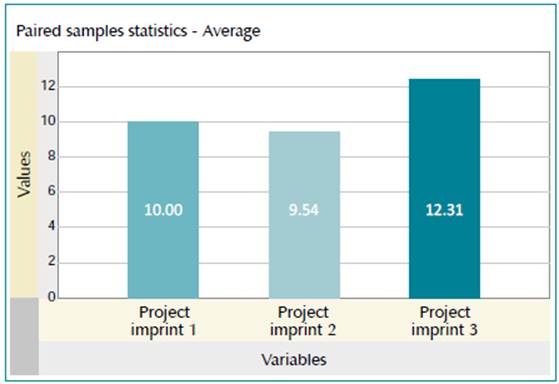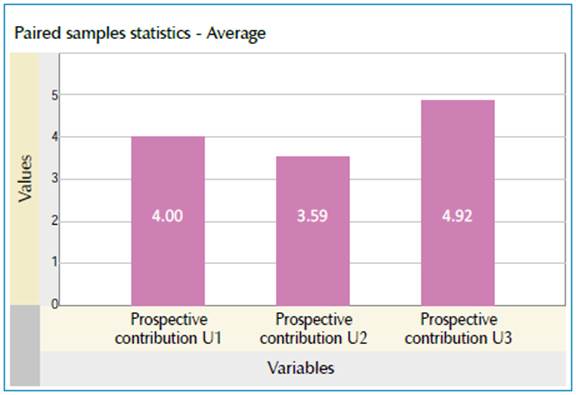Introduction
This article is submitted as the result of the final Master thesis titled Project Investigation as a Didactic Strategy in the Architectural Design Workshop, in line with research on Pedagogical Methods, at the Faculty of Architecture of Universidad Nacional del Centro Perú.
Research in higher education is quite rich as regards to knowledge, understanding, and language use as well as in reference to its scientific focus to solve its problems. Presently, all scientific disciplines related to professional specializations - above all the activity focused on higher education - carry out their research in order to create their own language and their own scientific focus, as it takes place in the architect's education. As part of the solution to the architect's learning, Project Research (PR) is proposed as a didactic strategy in the Architectural Design Workshop Project.
In the architect's education workshop there are two phases: the first is information, and the second, decision. They are resolved according to the teacher's methodological focuses, which take up one or more of the due processes: 1) deductive, 2) inductive, or 3) abductive. Regardless of which process is chosen, both phases demand a series of actions with a specific aim, defined as strategy. The strategy in this research is based on postulates and theoretical and pedagogical bases of Ferreiro's constructivism (2007) which pointed out, at the same time, the strategies for the constructivist paradigm.
To develop the project experience, as applied to the researched workshop, the abductive method was chosen, which is carried out simultaneously in both phases. That is why project research is, simultaneously, architectural information and solution that evolves permanently from conjecture to experienced conjecture. In order to bring in problem issues to the research, the information phase is widely taken into consideration as project research.
Project research is a didactic strategy in the education of the architecture student, who does not gain knowledge in an efficacious way due to various factors that influence the teaching-learning process and the way to project; this is reflected in recurrent architectural projects lacking innovative proposals, and which are submitted by architecture faculty students around the world and, especially, in the Latin American environment.
This strategy is a relevant procedure being implemented in the academic environs of the architect's education, and which is evidenced in Latin America, with Sarquis (2007); in Argentina, with the work on project research developed in the book Itinerarios del projecto [Project Itineraries] by Jaime Correa (2003); in Colombia, with the research work titled Investigación y proyecto arquitectónico [Research and Architectural Project]; and in Mexico, with Tappan's work and his research work titled La investigación proyectual: una propuesta que vincula docencia e investigación [Project Research: A Proposal Binding Teaching and Research], among others and which, in light of the results of our research, increase and consolidate this project strategy.
In spite of the above, there are diverse theories, methods, and techniques that focus on project research as a pedagogical activity: the architectural project Aprender investigando [Learning by Research]; project research in architecture; project architecture and project research; the pedagogy of the architecture learning workshop; learning to project through the analysis of project decisions; learning tools applied by architecture schools; strategy as of the construction of a project research; and others.
To solve project research as a didactic strategy a planned system was devised, a program that became the experimental plan with the before-method and the after-development of project research as a set of graded activities that allowed the 2017-1 tenth-semester students at the architecture faculty of Universidad Nacional del Centro Perú to increase their project level.
In this sense, the research provided an answer to the question: How does the application of project research as a didactic strategy influence the Architectural Design Workshop project?
The question posed, in turn, identifies, as the objective of the work to determine how the application of project research as a didactic strategy influences the Architectural Design Workshop project.
The development of the experimental plan in all its parts was useful to demonstrate the formulated hypothesis: The application of project research as a didactic strategy significantly influences the Architectural Design Workshop project.
The sample population consisted of 13 tenth-semester students from section A 2017-1 of the Faculty of Architecture of the Universidad Nacional del Centro Perú.
Among the basic contextualized references there is Jiménez (2003) with his article "Investigación y proyecto arquitectónico" [Research and architectural project], whose main purpose was "to specify the interaction between research and practical-reflective processes that overcome instrumental actions to solve the tensions between the objective doing and the construction of subjectivity..." (p.13) under a qualitative approach with a descriptive research design. The instrument was an analysis matrix.
Tappan's work (2012) was also taken into account in the project research, a proposal that binds teaching and research, and thanks to this purpose three key aspects can be introduced: 1) the interdisciplinary nature of a problem, 2) the creative act in the discovery and innovation phase, and 3) drafting them up within the creative process to then be able to apply them in teaching and research within a contextual, methodological and theoretical framework, and whose research design is descriptive. On the other hand, there is Pina (2004), who talks, in the architecture project, about scientific rigorousness as a poetic instrument (doctoral thesis).
The Universidad Politécnica de Madrid, provides the essential bases of the logical process of projection, with a qualitative-quantitative approach, whose research design is descriptive-correlational. In his project research in architecture, as studied in the Master graduation projects of architectural design at the Faculty of Architecture and Urbanism of Universidad Central de Venezuela (doctoral thesis), Zamora (2012) set out as a design method and strategy the theoretical bases on project research under the qualitative-quantitative approach; as a tool, he used a cartographic structure.
The contribution of the research comes across, first and foremost, from the basic theories for project research in architectural designs that tend to innovation in accordance to the development of science and society - which, at the same time, allowed to describe, explain, understand, interpret, test and attempt the transformation of the reality habitat.
Firstly, there are the contributions of project research as a way to develop knowledge in architecture, as proposed by Sarquis (2007) in his two books on epistemological fiction and fiction of the real. As project itineraries, they were of outmost importance since they allowed to scrutinize the prolegomena of project research. Sarquis proposes architecture as a consequence of social practice, disciplinary knowledge, the habitat members, the existing, the examples, the traces, and the analysis of poietic products.
On the other hand, Muntañola (2011) proposes as analytical reflections the projectual imagination, the projectual logic and the projectual architecture.
Another reference that reinforces this research is that of Fernandez (2013), who developed the concepts on: the theory gap; what to research, how and for what; how to elaborate a research text; and the products and perspectives of eco-projects. As a contribution to project research, the same author proposes the existence of some project knowledge; he goes over his themes as of a general theory of habitat and project research as the bases for scientific research, and he lays down an agenda of topics for project research.
For this research, Ferreiro's postulates and his theoretical-pedagogical bases on constructivism (2007, p.27) were adopted, as they pointed out his contribution to the following constructivist paradigm:
Project research as a didactic strategy for the Architectural Design Workshop is cognizible.
Any architecture student and all teachers are able to know project research as a didactic strategy by the Architectural Design Workshop in its successive approximations.
The knowledge-acquiring process of project research as a didactic strategy by the Architectural Design Workshop is an active one, and it is characterized by the function of the consciousness and feelings of the subject who is learning.
Knowledge acquired through project research as a didactic strategy of the Architectural Design Workshop is not innate nor is it provided a priori. It is build up by architecture teachers and students. They appropriate it through activity and language.
The architecture student who learns is not the only one responsible for the process of knowledge construction: the environment is a condition for its development.
As a basis for the architecture project, from Vitruvius (2002) and his ten books on architecture up to the contemporary ones were taken into account: Le Corbusier (1959), and his Mensaje a los estudiantes de arquitectura [Message to Architecture Students]; Alexander (1976), and his Ensayo sobre la síntesis de la forma [Essay on the synthesis of form]; Quaroni (1980), with Proyectar un edificio: ocho lecciones de arquitectura [Projecting a building: eight architecture lessons]; Purini (1984), with La arquitectura didáctica [Didactic Architecture]; Munari (1990), with Diseño y comunicación visual [Design and Visual Communication]; Muñoz (2016), with El proyecto de arquitectura, concepto proceso y representación [The architecture project, concept process, and representation]; and the sequence of theoretical contributions up to the present.
From the Latin American environs, contributions by Villagrán (1988) with his theory of architecture and, from the Peruvian context, Ludeña (1997), and La arquitectura en el Perú del siglo XX. [Architecture in XX Century Perú] were also taken into account.
As regards the validity of studies and state of the art, there is a wide range of works, out of which, in their function of project research variable as a didactic strategy, the following articles are quoted: Bhooshan's (2017) "Pensamiento de diseño paramétrico: un estudio de investigación arquitectónica integrada en la práctica" [Parametric design thought: a study of architectural research integrated into the practice]; Xue and Desmet's (2019) "Investigación introspectiva para la investigación de diseño basada en la experiencia" [Introspective research for design research as based on experience]; and from Kho-deir's (2018) "Métodos de aprendizaje combinado como un enfoque para enseñar la gestión de proyectos a estudiantes de arquitectura" [Combined learning methods as an approach to teach project management to architecture students].
For the variable The Architectural Design Workshop Project, AboWardah (2019) is quoted: "Cerrar la brecha entre las fases de investigación y diseño esquemático en la enseñanza de proyectos de graduación arquitectónica" [To close the gap between the research phases and schematic design in the teaching of architectural graduation projects]. And by Ghonim and Eweda (2019), "Perspectivas de los instructores sobre la pedagogía de los proyectos de graduación arquitectónica: un estudio cualitativo" [Instructors' perspectives on the pedagogy of architectural graduation projects: a qualitative study].
The main point of project research as a didactic strategy is not only prevailing but, in addition, it keeps finding new applications based on novel theories or IT technologies within the problem-besieged learning system of the Architectural Design Workshop.
Methodology
The quasi experimental study took place with the participation of students from the Design Workshop 10, Section A, of the Architecture Faculty of Universidad Nacional del Centro Perú, from the 2017-1, the tenth final semester of their career.
At the start of the workshop the Visual-Audi-tory-Kinesthetic (VAK) survey-questionnaire was applied; it is a neurolinguistics programming test that determined the type of learning style students had, such as visual, 56 %; auditory, 1 7 %; and kinesthetic, 29%. It was a heterogeneous population with their own learning styles and architectural projection, which was later taken into account in the implementation of the research methodology.
The type of research, taking into account its purpose, was characterized as applied; due to its temporary reach, as sectional; by its depth, as explanatory, by its amplitude, as micro-sociological; by its sources, as mixed; by its character, as quantitative; and by its nature, as quasi-experimental. These characteristics were taken from Sierra (2001), and Hernández and Mendoza (2018).
In Figure 1 can be seen the methodological structure and the experimental procedure of independent variables X1 and X2, whose reactive mode is the planning strategy and implementation in didactic units 1 and 2.
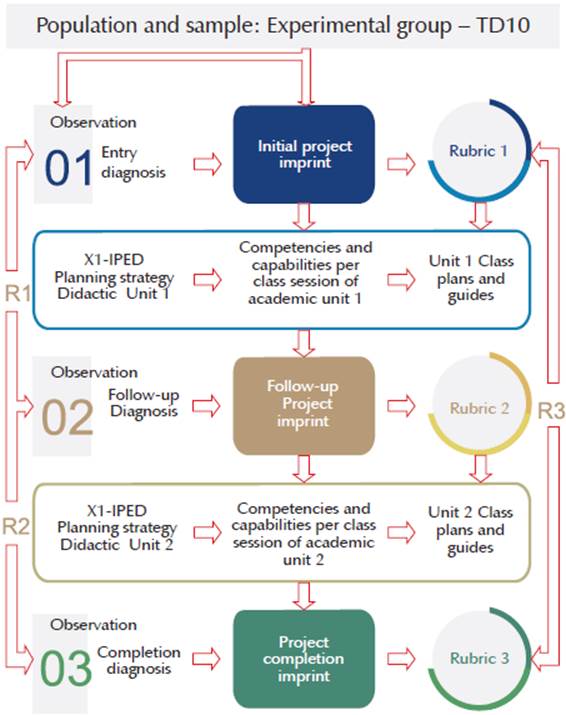
Source: Sierra (2001) and Hernández et al. (2014).
Figure 1: Methodological structure and experimental procedure; the design is made into a graphic of a single group G1: O1 X O2 X O3 with their results 1, 2 and 3.
The experimental planning method with a strategy regarding quality, productivity and competitiveness was structured in a systemic manner using the strategy of quality, productivity, and competitiveness proposed by Deming.
Figure 2 shows the planning of the experimental structure program in the syllabus, and its execution, control and evaluation process, which will be reflected in the results.
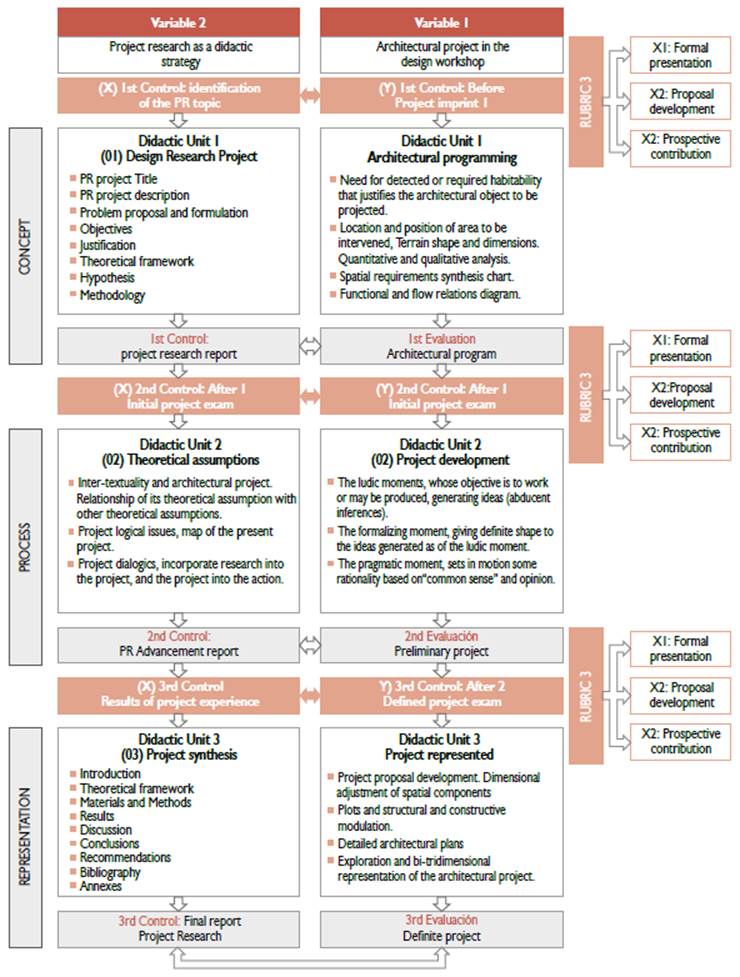
Source: Author's own elaboration (2017). CC BY-NC.
Figure 2 Planning, execution, control and evaluation of experimental program.
Evaluation of learning by competences as applied to the experimental program is represented in Figure 3. At the start of each one of the three academic units of the architectural project workshop, the entrance test was applied as a project imprinting, assessed as a sudden, short, and fast architectural solution. It is a synthesis moment, as represented in architectural drawings and a physical scale model that depicts the student's capability and aptitude to solve architectural problems in a single session. A solution or an architectural proposal for an architectural program in a given terrain is materialized on the basis of the project research theme (generating idea) that gives emphasis to the proposal whose solution solves a habitat problem posed.
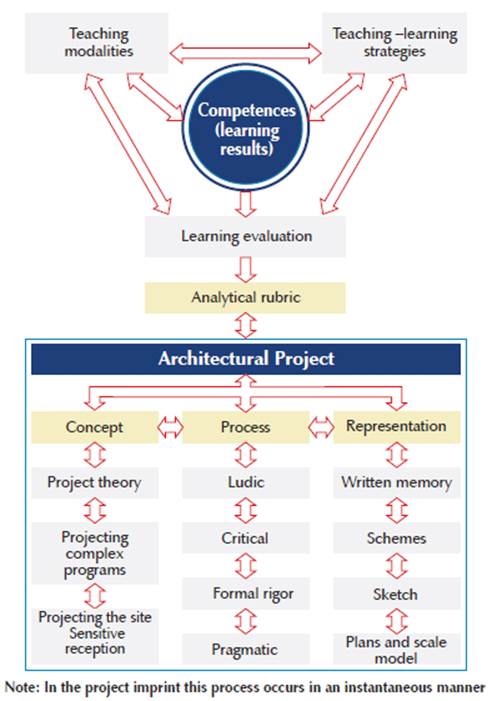
Source: author's own elaboration (2017), based on Mezarina et al. (2016). CC BY-NC.
Figure 3 Learning evaluation of the architectural project.
In Figure 4, in the conjunction of knowledge, project research is shown as an intersection between program research of the architectural project and the solution of the architectural object. The said process is assumed as of the general program up to the time to make decisions as given by the design imprint.
The analytical rubric instrument is the one measuring the application of the experimental program which, at the same time, was constructed according to the characteristics shown in Table 1.
Table 1 Base construction str
| Performances to be evaluated | Rating Scale | ||||
|---|---|---|---|---|---|
| Performances | Indicators | Very good (4) | Good (3) | Average (2) | Deficient (1) |
| Performance 1 | Activity | Hierarchy-detailed Inclusive 100 % - 81 %) | Hierarchy-detailed Inclusive (80%-61%) | Hierarchy-detailed Inclusive (60%-41%) | Hierarchy-detailed Inclusive (40% - 0%) |
| Process | |||||
| Impact | |||||
| Performance 2 | Activity | Hierarchy-detailed Inclusive (100%-81%) | Hierarchy-detailed Inclusive (80% - 61%) | Hierarchy-detailed Inclusive (60%-41%) | Hierarchy-detailed Inclusive (40% - 0%) |
| Process | |||||
| Impact | |||||
| Performance 3 | Activity | Hierarchy-detailed Inclusive (100%-81%) | Hierarchy-detailed Inclusive (80%-61%) | Hierarchy-detailed Inclusive (60%-41%) | Hierarchy-detailed Inclusive (40% - 0%) |
| Process | |||||
| Impact | |||||
| Indicators criteria | Performance level descriptors | ||||
Source: Author´s own elaboration (2017). CC BY - NC.
The rubric for the architecture project evaluation was supported by research-action, characterized by its being practical, and which led to the improvement of the project trial, as participative and collaborative, when applied as self-evaluation, co-evaluation, and hetero-evaluation, as well as critical; this allowed to evaluate feedback as theory, methods, and techniques applied to the teaching-learning process in the Architectural Design Workshop.
Thus, the evaluation rubric is binding in relation to the evaluation of the processes in the Architectural Design Workshop Project, and it is the foundation for the results of the architectural project in the education process of the future architect.
The architectural project as a by-product of architectural design, presently continues evaluating in an arbitrary and intuitive manner since teachers do not count on consistent instruments to carry out that process. With this instrument, self-evaluation, co-evaluation, and hetero-evaluation are guaranteed.
Results
Practical experimentation with professional architects exercising teaching, and students, in their professional training as architects, was carried out as a learning proposal through project research as a didactic strategy for the Architectural Design Workshop. It was a mutual approach, involving both, teacher and student. It was deconstructed throughout the experimental process and reconstructed in the results into a rather complex system, full of details summarized in the outcomes obtained and in the contrasts that the theory and its advances allow us to detail.
The qualitative treatment of the data was obtained from the evaluation of the graphic material presented as empirical evidence of the results, as outlined in Figure 5.
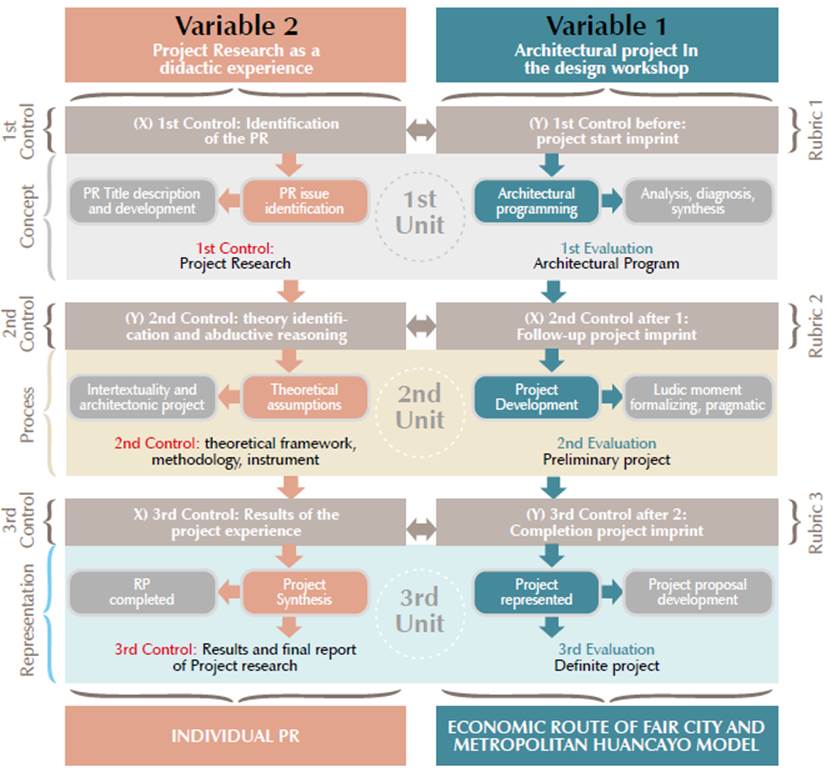
Source: author's own elaboration (2017). CC BY-NC.
Figure 5 Implementation of planning, execution, control, and evaluation of experimental program.
The graphic results of the entry diagnostic design imprint are presented in Figure 6, which also shows a great potential for formal design with very elementary and basic information of a training in design research.
Graphic results of the follow-up project imprint are shown in Figure 7, where project research application of the project theoretical conjecture can be observed, with a theoretical-conceptual management as applied to the main urban theme and its individual architectural projects.
Graphic results of the project completion imprint are shown in Figure 8, where the application of project research interacting with the urban project and its individual architectural projects can be seen, as reflected in their architectural part and the preliminary project.
The graphic results of the final architectural project are shown in Figure 9, which shows the final results of the project research interacting with the urban project and their individual architectural projects, reflected in the final architectural project.
As a correlate of the empirical graphic evidence, the quantitative results of the evaluation rubrics are developed.
The quantitative treatment of the data was done using descriptive and inferential statistics, and the data were processed using Spss 24.
At the beginning, the overall normality test based on the theoretical rule for statistic decision was used:
Theoretical rule:
If the significance value is > 0,05, it is normal.
If the significance value is < 0,05, it is not normal.
From Table 2 the following normal distribution data may be obtained:
Project imprint 1: 0,200> 0,05 is normal.
Project imprint 2: 0,072 > 0,05 is normal.
Project imprint 3: 0,001 < 0,05 is not normal.
Table 2 General normality test.
| Kolmogorov-Smirnov | |||
|---|---|---|---|
| Statistic | gl | Sig. | |
| Project imprint 1 | 0,192 | 13 | 0,200* |
| Project imprint 2 | 0,225 | 13 | 0,072 |
| Project imprint 3 | 0,308 | 13 | 0,001 |
Source: author's own elaboration (201 7). CC BY-NC
Statistical decision: because of the above, when no normality was shown in the whole of the evaluations, Wilcoxon's non-parametric test was applied.
Once the normality test for verifying the specific hypotheses was performed, it was concluded that if there was one or more non-normality data, the Wilcoxon non-parametric test should be used.
Once the preliminary results were obtained, and having established Wilcoxon's non-parametric test as the test statistic, the general hypothesis test was
Theoretical rule:
Ho: There is no significant difference between initial assessment i and initial assessment j.
H1: There is a significant difference between initial assessment i and initial assessment j.
Wilcoxon's test shows that in the first case Ho (p1 = 0,389 > 0,05) is not rejected, and in the second and third cases, Ho (p2 = 0,015 < 0,05; p3 = 0,002 < 0,05) is rejected.
Statistical decision: from Table 3 and Figure 10 it may be deducted that the results of project imprint 3 are the ones showing a higher average, which points out that the application of project research has significantly influenced procedures and architectural project as developed by the Architectural Design Workshop.
Table 3 Tests statistics of Wilcoxon general test.
| Test statistics | |||
|---|---|---|---|
| Project imprints: 1-2 | Project imprints: 1-3 | Project imprints: 2-3 | |
| Z | -,861b | -2,439c | -3,071c |
| Asymptotic (bilateral) | 0,389 | 0,015 | 0,002 |
Source: author’s own elaboration (2017). CC BY-NC.
Testing of hypotheses specific to the formal presentation dimension.
Theoretical rule:
Ho: There is no significant difference between the results of the formal presentation of Unit i and the results of the formal presentation of Unit j.
H1: There is a significant difference between the results of the formal presentation of Unit i and the results of the formal presentation of Unit j.
Wilcoxon's test shows that in the first case Ho (p1 = 0,312 > 0,05) is not rejected, and in the second and third, Ho (p2 = 0,014 < 0,05; p3 = 0,005 < 0,05) is rejected.
Statistical decision: From table 4 and Figure 11 it is deduced that the formal dimension presentation of Unit 3 project imprint is the one that shows a higher average which, at the same time, indicates that the application of project research has significantly influenced the procedure and architectural project as developed by the Architectural Design Workshop.
Table 4 Test statistics of Wilcoxon test on the formal dimension presentation.
| Test statistics | |||
|---|---|---|---|
| Formal Presentation: 1-2 | Formal Presentation: 1-3 | Formal Presentation: 2-3 | |
| Z | -1,011 | -2,453 | -2,781 |
| Asymptotic (bilateral) | 0,312 | 0,014 | 0,005 |
Source: author´s own elaboration (2017). CC BY-NC.
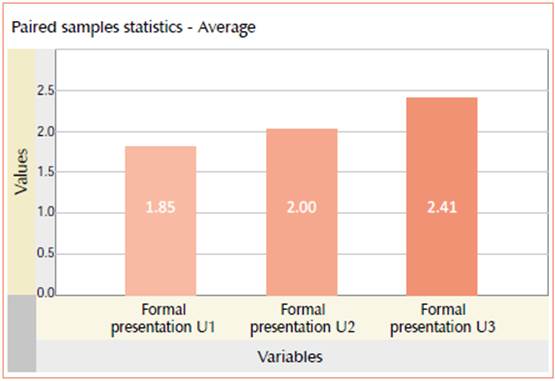
Source: author's own elaboration (201 7). CC BY-NC.
Figure 11 Averages of the formal dimension presentation.
Specific hypothesis on the development dimension of the proposal.
Theoretical rule:
Ho: There is no significant difference between the results of the development of the unit i proposal and the development of the unit j proposal.
H1: There is a significant difference between the results of the development of the unit i proposal and the development of the unit j proposal.
Wilcoxon's test shows that neither in the first nor in the second case Ho (p1 = 0,652 > 0,05; p2 = 0,061 > 0,05) are rejected, and in the third Ho; p3 = 0,009 < 0,05) is rejected.
Statistical decision: From Table 5 and Figure 12, it is deducted that the development dimension of the proposal of project imprint for unit 3 is the one that shows a higher average which, at the same time, indicates that the application of Project Research has significantly influenced the procedures and architectural project as developed by the Architectural Design Workshop.
Table 5 Wilcoxon test statistics of the development dimension of the proposal.
| Test statistics | |||
|---|---|---|---|
| Development of proposal: 1-2 | Development of proposal: 1-3 | Development of proposal: 2-3 | |
| Z | -1,059b | -1,809c | -2,739c |
| Asymptotic (bilateral) | 0,289 | 0,070 | 0,006 |
Source: author's own elaboration (2017). CC BY-NC.
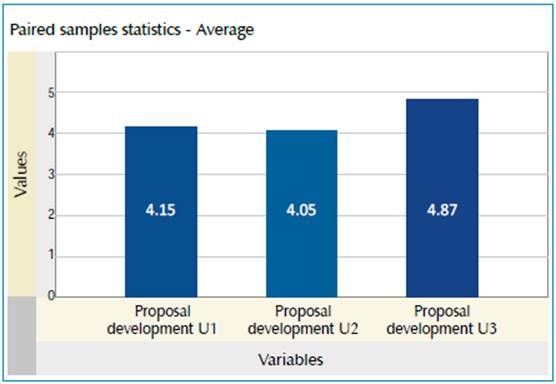
Source: author's own elaboration (2017). CC BY-NC.
Figure 12 Averages of the development dimension presentation.
Specific hypothesis of the prospective contribution dimension.
Theoretical rule:
Ho: There is no significant difference between the results of prospective contribution i and the results of prospective contribution j.
H1: There is a significant difference between the results of the prospective contribution i and the results of prospective contribution j.
Wilcoxon's test shows that neither in the first nor in the second case Ho (p1 = 0,289 > 0,05; p2 = 0,070 > 0,05) are rejected, and in the third Ho; p3 = 0,006 < 0,05) it is rejected.
Statistical decision: From Table 6 and Figure 13 it can be deducted that the results of the prospective contribution of unit 3 is the simple with a higher average, which indicates that the application of Project Research has significantly influenced the procedures and the architectural project as developed in the Architectural Design Workshop.
Table 6 Wilcoxon test statistics of the prospective contribution dimension.
| Test statistics | |||
|---|---|---|---|
| Prospective contribution: 1-2 | Prospective contribution: 1-3 | Prospective contribution: 2-3 | |
| Z | -,451b | -1,875c | -2,607c |
| Asymptotic (bilateral) | 0,652 | 0,061 | 0,009 |
Source: author´s own elaboration (2017). CC BY-NC.
Discussion
The design workshop project and the teaching-learning process have gone hand-in-hand with the development of the research, where -in each part of the process- it was necessary to review the theoretical postulates and background upon which research is based, resolving concrete situations through constant feedback that generated a mutual interactive learning dynamics between the teacher and the student. Results are contrasted with theory and background supporting them as regards the systematized points of the experience gained in the project research work as a didactic strategy.
Contributions by project research as proposed by Sarquis (2007) in his books Ficción epistemológica y Ficción de lo real, itinerarios del proyecto [Epistemological Fiction and Fiction of the Real, Itineraries of the Project], which are the outcome of his doctoral thesis and served as the basis for his application to the Master's and Doctorate degree of the same name at Universidad de Buenos Aires (UBA); in our case were introduced as undergraduate experience, and to do so was a wholesome challenge. The results of Project Research as a didactic strategy in the Architectural Design Workshop project have been significant and point out that it is a valid strategy to be applied in undergraduate studies.
When in his book El proyecto de arquitectónico aprender investigando,Jiménez (2006) demonstrates the importance that the project generates knowledge in the student, he does it from the point of view of expert judgment, unlike the present research, in which this is demonstrated by the evaluation of the production of the architectural projects worked on by the students, and thus validates the same hypothesis from an experimental work.
It is feasible to implement organizational theories and proposals in the experimental program inserted in the TD10 syllabus, as is the case with Deming's theory of quality, productivity and competitiveness (1989), in its four processes adapted to the developed program of planning, execution, control and evaluation, as of didactic optics and strategies.
In order to operate the variable Architectural Design Workshop Project, it was processed within Muñoz' theoretical framework (2016), and his book El proyecto de arquitectura [The Architecture Project]. He develops his proposal in two environs: 1) the professional practice, and 2) the architect's educational process. It is this second aspect the one taken as a basic reference, and it is corroborated for the drafting of the analytical rubric instrument, which evaluates the project start imprint, its follow up, and the completion of the research. His definitions and concepts on details of the architectural project become relevant within the evaluation tools of the analytical rubric and the results obtained.
For the development of the project it was necessary to take into account all the concurrent referents to the object of the research; therefore, the work of Martinez (2013)The architectural project as a research problem had as its main objective to propose the identification of methodological processes to develop the practice of architectural design, which is summarized in the architectural programming. His contribution was substantial in the preparation of the items of the formal presentation dimension of the analytical evaluation rubric.
The application of project research as a didactic strategy has significantly influenced the procedures and the architectural project developed in the Architectural Design Workshop, and it can be replicated for the training of architects in the various modalities of architectural workshops held in Latin America.
Conclusions
By detailing the application of the project imprint evaluated by the analytical rubric in its general results and in its three dimensions (formal presentation, proposal development, and prospective contribution), the following conclusions can be reached:
From the application of the three project imprints, at the start of each unit and the statistical analysis of the first and second one, the first and third one, the second and third one, the results proposed in the research project were obtained, which point out that the application of project research as a didactic strategy in the first unit does not manage to go beyond their prior knowledge. And for the second and third units, the adaptation stage has been surmounted, obtaining the final result, which has significantly influenced the procedures and the architectural project developed in the Architectural Design Workshop.
In the specific dimensions, similar to the general analysis, it is observed that for the formal presentation dimension the results of the project imprint at the start of each unit and of the statistical analysis of the first and second one, the first and the third one; the second and third show that in the first unit prior knowledge is not surpassed in the formal presentation dimension; and for the second and third units, the adaptation stage has been overcome as regards the application of project research as a didactic strategy.
In the proposal development dimension, results of the project imprint were compared at the start of each unit, and the statistical analysis shows that in the first and second unit their previous knowledge is not surpassed, and for the third unit, the adaptation stage has been overcome regarding the application of project research as a didactic strategy.
In the prospective contribution dimension imprint results were compared at the beginning of each unit, and the statistical analysis of the first and second one, the first and the third one; the second and third one show that the application of project research as a didactic strategy in the first and second units does not manage to surpass the previous knowledge in the prospective contribution dimension, and for the third unit, the adaptation stage has been surmounted as to the application of project research as a didactic strategy.











 text in
text in 

